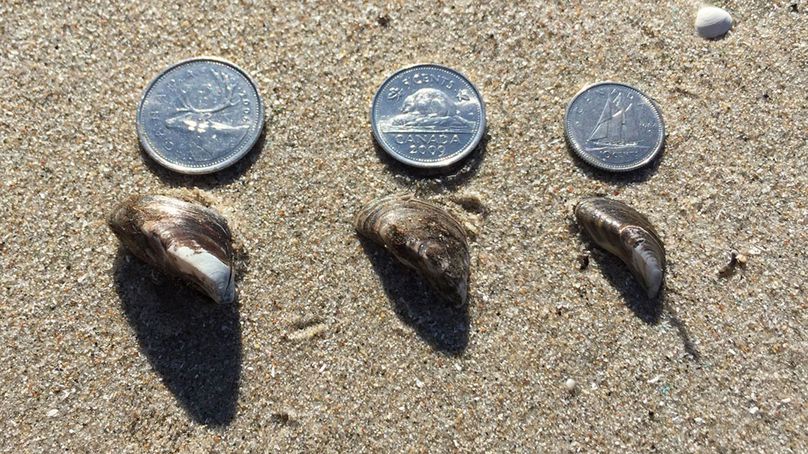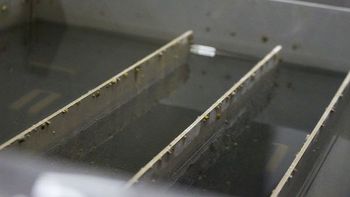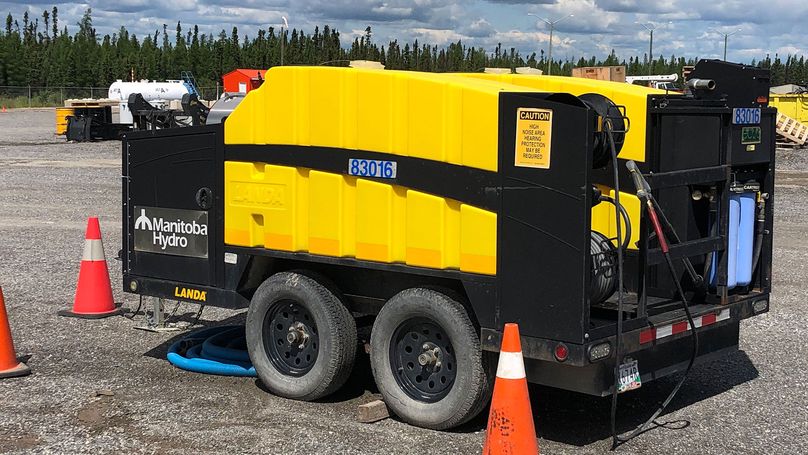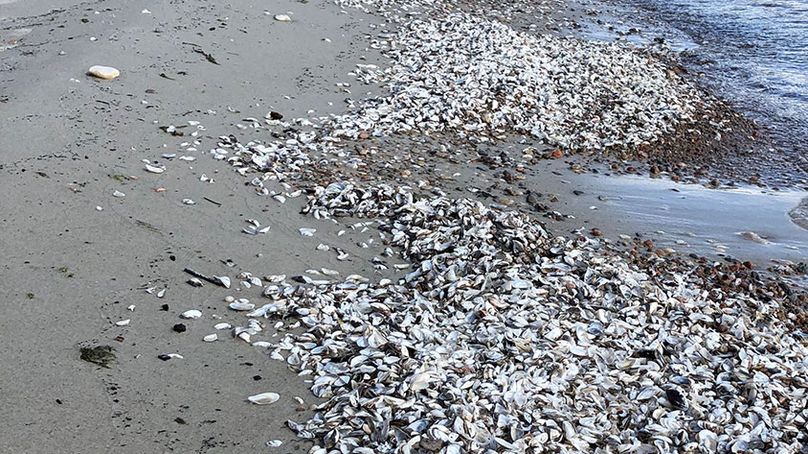When it comes to invasive species in Canada’s waterways, the zebra mussel is one of the more prevalent.
Zebra mussels were introduced to North America in the 1980s via cargo ships travelling through the St. Lawrence Seaway system. By the end of that decade, the mussels were found in the Great Lakes.

Mussels coating a spillway gate at Kettle Generating Station.
Each female zebra mussel can produce one million eggs per year. The microscopic offspring, known as veligers, are as small as one-tenth of a millimetre and can be highly mobile in waterways in their early development. The adult mussels can encrust lake bottoms and virtually any other surface in raw water.
In 2013, the mussels were detected in Lake Winnipeg; by 2019, they had moved into the Nelson River, an outflow of Lake Winnipeg.
“There are significant ecological and economic impacts which have been consistently recorded across North America associated with zebra mussel invasions,” said Mat Bannerman an environmental specialist with Manitoba Hydro.
Manitoba had the hindsight of seeing the impact of the mussels in Ontario — and on that province’s hydroelectric operations — prior to their spread here. While the initial hope was that the northern climate of Manitoba, with its cooler water temperatures and shorter growing season, would dampen zebra mussel range and density, that has not been the case.

Zebra mussels displayed alongside coins for scale.
“We’ve been monitoring for zebra mussels for many years,” Mat said. “But once they were found in Lake Winnipeg, we really enhanced monitoring into Northern Manitoba, knowing that the Nelson was also going to be greatly impacted. Fast forward since then, we found mussels at Jenpeg in 2018 and in 2019, we found them all the way to Limestone’s forebays.”
In his role with Generation Environmental Services, Mat’s main concern is mussel growth inside of our cooling water assets and fire protection systems, specifically hydroelectric facilities. He is also tracking zebra mussel settlement inside Converter stations in the North.
“Since 2021, we have been seeing mussels settling inside of our assets,” Mat said. “Anything that’s situated in the raw water of a contaminated water body is seeing mussel growth. Our biggest risk is having mussels settling inside pipes and clogging cool water systems. When you have generators creating a bunch of heat, you need that cool water circulating through to provide a cooling effect.”
Tracking zebra mussels
To stay on top of zebra mussel populations within our assets, Mat has set up bio-boxes at our hydroelectric facilities and converter stations.
“Zebra mussels flow through these bio-boxes much like they flow through our units,” Mat said. “We have close to 50 bio-boxes that operate across the province all year long.”
Zebra mussels attach to the substrate plates in the bio-boxes and our chemists scrape the mussels off the plates to get a density count. This allows us to gain an understanding of how many mussels are growing within each station.
“The bio-boxes kind of act like the proverbial canary in the coalmine and tell us when chlorine treatment is required,” Mat said. “We’re very fortunate to work with the Selkirk lab and have a great monitoring program. It really takes a team effort to try and stay on top of these critters.”

Close up of a bio-box.
Chlorine treatment
When bio-box numbers are too high, we use a low-level chlorine treatment to address zebra mussels in hydroelectric operations. Chlorine treatment is the most effective method to control adult zebra mussel growth and is widely used at other hydroelectric generating stations in North America.
“We inject chlorine, at a very minute dose, into our cooling water line as it enters the station,” Mat said. “The level is similar to what is in our drinking water, so it is around 0.6 parts per million.”
Treatments takes approximately two weeks to kill off zebra mussels inside the facility. The chlorinated water is neutralized prior to it being released back into the river system.
“We don’t discharge the chlorinated water straight into the river, we neutralize with sodium bisulfite first,” Mat said. “This wasn’t something initiated from a regulatory standpoint, it was something we wanted to do to ensure we aren’t having additional impacts on the waterways.”
Six Hydro facilities received the chlorine treatments over the previous two summers. That number will increase to seven facilities in 2023, our third year of chlorine treatments.
“If we didn’t go in and kill off some of the mussel population, we’d be seeing reliability issues,” Mat said. “We would have pressure differentials changing and experiencing overheating.”
While the treatment regimens are preserving reliability, Mat noted that we are starting to see zebra mussels on our civil structures, such as gates, gains, intakes, trash racks and stop logs.
“We can have three to four inches of growth on some of these structures,” Mat said. “So, we can start to see weight issues, where you have equipment that is designed to lift and then you have zebra mussels causing additional weight. They can cause lots of complications that we didn’t foresee.”
Mussel mitigation for our watercraft
Over the past decade, the Province of Manitoba attempted to mitigate the spread of zebra mussels in our system of lakes and waterways. The province set up control zones and required all commercial and private boats to be decontaminated and treated for zebra mussel veligers when moving from to and from control zones.
Manitoba Hydro contributed to that control effort by purchasing decontamination units — known as LANDAs — for the province to use for commercial and private watercraft alike.

A LANDA decontamination unit.
“It really looks like the zebra mussels are here to stay, and we are kind of adapting,” said Greg Szocs, a field safety coordinator with Manitoba Hydro. “Our boats come out of the water every day, so we have a range of measures in place where we can mitigate in advance the chances of spreading this.”
As the zebra mussel continued its spread in Manitoba, the number of control zones have been reduced; for example, the Red River, Lake Winnipeg and the Nelson River, which were initially in separate zones, have been combined into one.
“While the zebra mussel spread is a concern, having zones combined actually benefits our operations greatly,” Greg said. “You previously weren’t allowed to move from one part of a control zone to another without decontaminating.”
Manitoba Hydro currently owns three LANDA units for decontamination. As part of our waterways procedures, boats are kept in the same waterways as much as possible.
“We designate boats to certain waterways, and they stay there, unless they need to come to Thompson for servicing,” Greg said.
When boats are brought in for servicing at Thompson, they are inspected and decontaminated before they go in for repairs. If the repair shop then tests the boat we can be assured that there will be no spread of aquatic invasive species.
“The decontamination process involves high pressure water at 60 degrees Celsius,” Greg said. “That will cook and blast any of those little passengers off of the vessel.”
For recreational boaters, Greg pointed to Manitoba’s Invasive Aquatic Species regulations and strategies for stopping their spread.
“I think the message to people boating on a recreational basis, is just to be extremely careful… once these species are there, there’s really no opportunity to get rid of them.”
Long-range impacts
The long-term impacts of zebra mussels in Manitoba’s waterways continues to play out. The plankton-eating mussels, which can filter a litre of water per day, are decimating the bottom of the freshwater food chain.
Employees on both Lake Winnipeg and the Nelson River are noticing increased water clarity.
“Think of millions and millions of tiny kidneys filtering the water — there are a lot of other aquatic species that rely on what zebra mussels eat,” Mat said. “Where you once had muddy, chocolate milk coloured water at both Lake Winnipeg and the Nelson River, now we’re getting reports from employees that they can see feet into the water column. It sounds like a good thing, but it’s really not — what you’re witnessing is the beginning of ecosystem collapse.”
When it comes to managing populations on a wide scale, the zebra mussels’ aggressive spread will perhaps be its own regulator.
“The populations will get to a point to where the water systems can no longer sustain them and we’ll see a collapse,” Mat said. “At this point, we are really relying on the zebra mussels to grow themselves out of house and home.”
Read more about how we give back to our community in our Environment, Social, and Governance Report.




